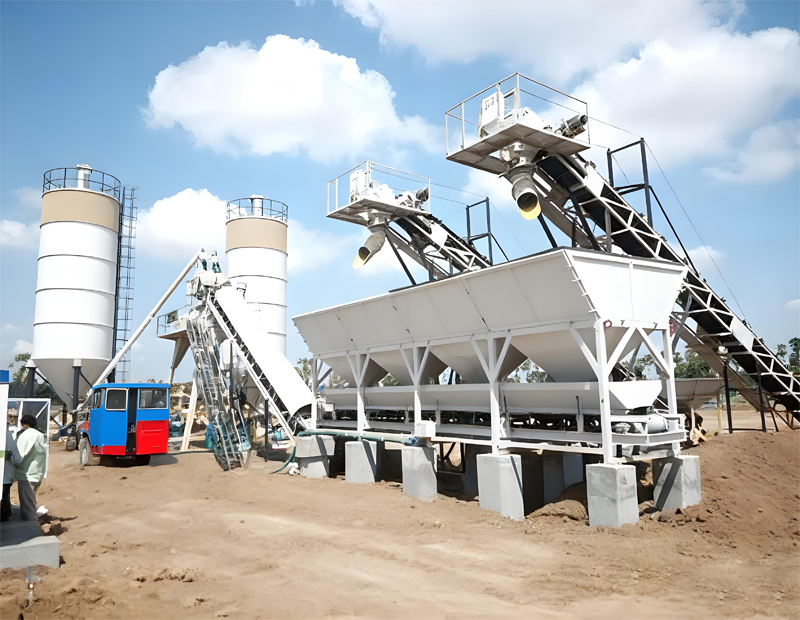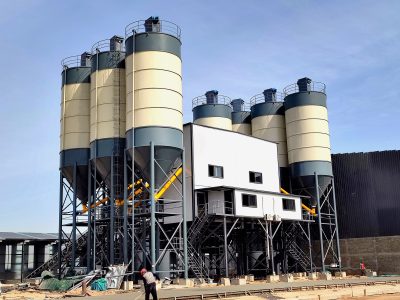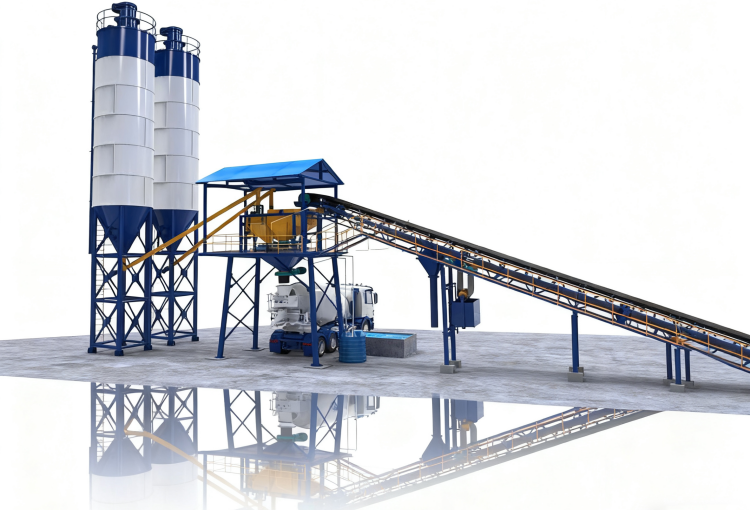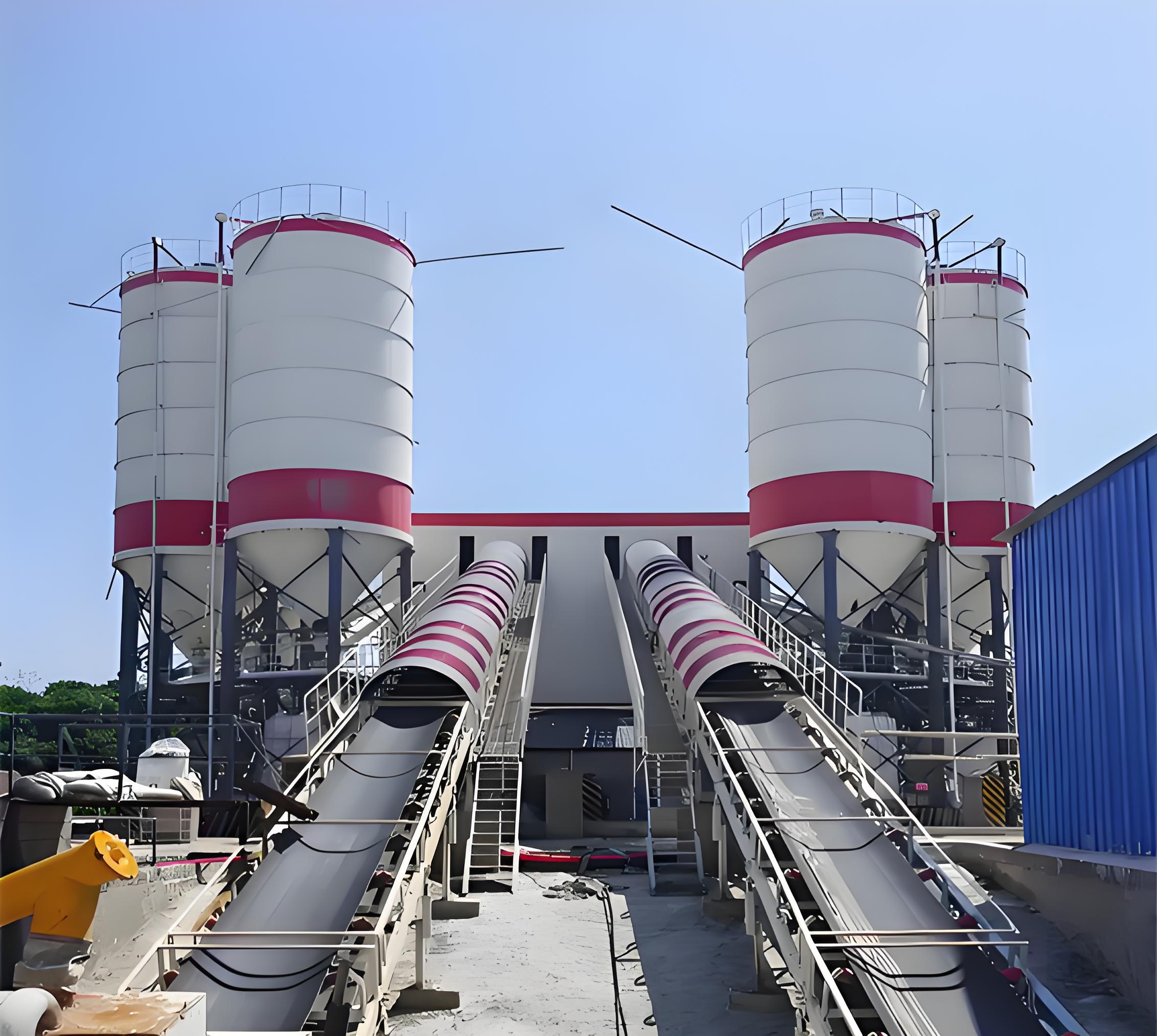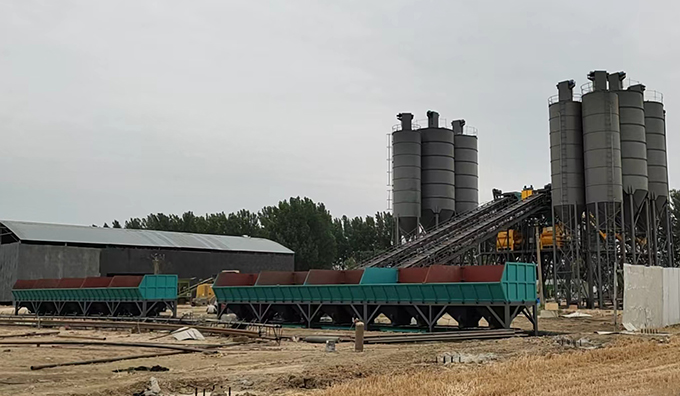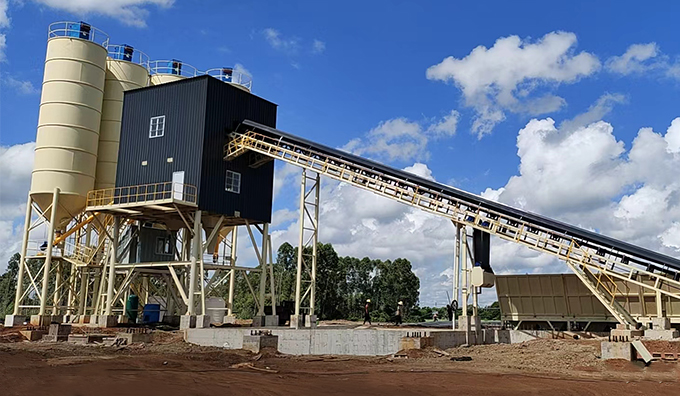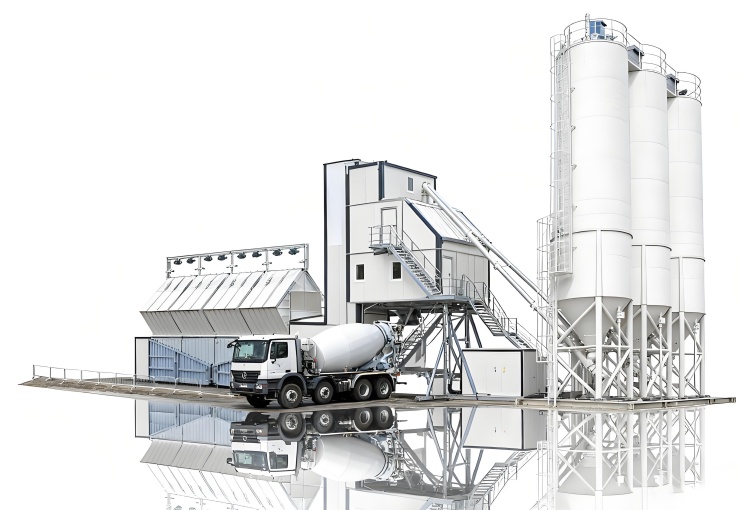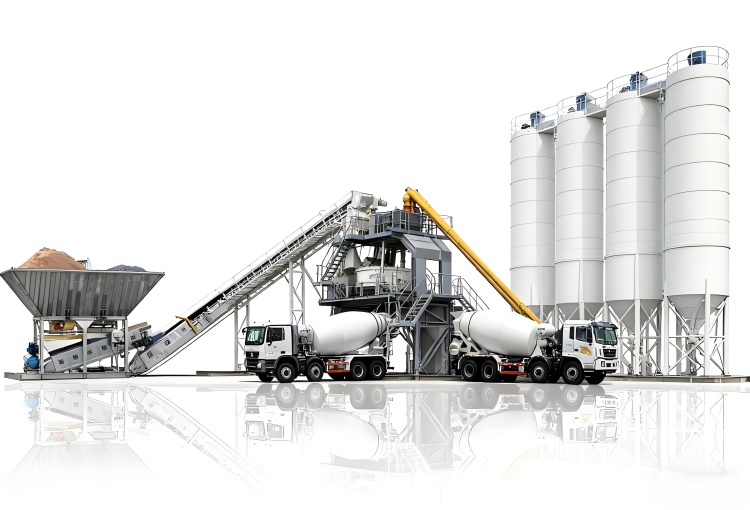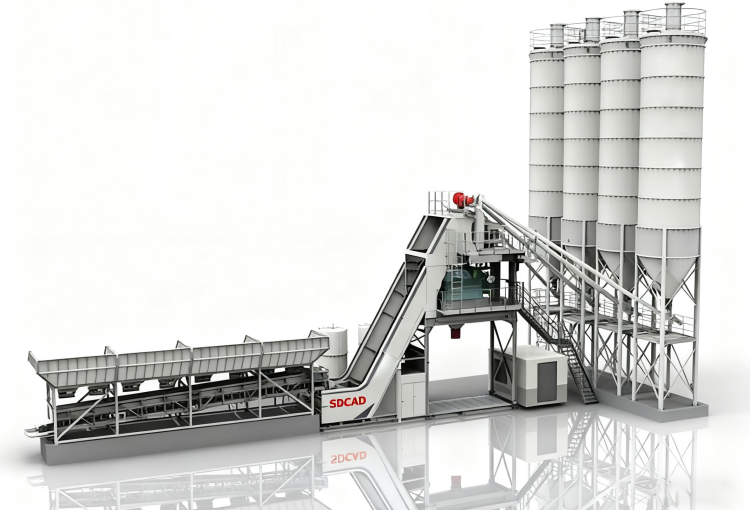“If you’re new to construction projects or planning to buy mixing equipment, you might wonder: What exactly is a concrete mixing plant? And how does it differ from small mixers? Many people confuse it with portable mixers, leading to wrong purchasing decisions.”
In the United States, it is called Concrete batching plant,In France, it is called Centrale de béton,In Germany, it is called Betonwerk,In Spain, it is called Planta de dosificación de hormigón,In Brazil, it is called Central de betão,In Italy, it is called Centrale di calcestruzzo,In Japan, it is called コンクリート配合プラント (Konkurīto haigō puranto),In Russia, it is called Бетонный завод (Betonnyy zavod),In India, it is called कंक्रीट बैचिंग प्लांट (Kankrīt baiching plānt),In Australia, it is called Concrete batching plant。It can be seen that the names of concrete mixing plants are different.
According to Wikipedia, a concrete batching plant is a complete set of equipment used for the industrial production of concrete. It precisely measures and mixes raw materials such as cement, aggregates (sand, stone), water, and admixtures to produce a concrete mixture that meets project requirements. Its core function is to combine various materials in predetermined proportions, enabling standardized, large-scale production. It is widely used in infrastructure construction, including buildings, bridges, and roads.
What is the operating principle of a concrete mixing plant?
Cement is held in tall, cylinder-shaped silos, sand and crushed rocks are kept in big storage bins, and water is stored in tanks. All these storage places have simple level markers, so workers can easily see when they need to add more materials.
A weighing system measures out each raw material in exact amounts—for example, 1 portion of cement, 2 portions of sand, and 3 portions of crushed rocks—depending on what type of concrete is needed (like C30 or C40 for different building jobs).
The measured materials are sent to a mixer (which may have two spinning shafts or a “planetary” mixing design). They’re mixed for 1 to 2 minutes until the concrete becomes smooth and evenly mixed throughout.
The mixed concrete is poured into special trucks called concrete transport mixers, and these trucks then carry the concrete directly to the construction site.
Concrete Batching Plant Types: Ultimate Guide for Construction Success
Choosing the right concrete batching plant isn’t just about picking equipment—it’s about aligning your choice with project goals, budget, and local regulations. Whether you’re building a highway in North America, a residential complex in Europe, or a small community center in Asia, the wrong plant type can lead to delayed timelines, wasted materials, or unexpected costs. This guide breaks down the most common concrete batching plant types, their unique advantages, and how to match them to your specific construction needs—with real-world examples to avoid costly mistakes.
1. By Core Function: Ready-Mix vs. On-Site Batching Plants
The first step in choosing a plant is understanding who will use the concrete and how it will be distributed. This splits plants into two primary categories: ready-mix plants (for commercial sales) and on-site (project-specific) plants.
Ready-Mix Concrete Batching Plants (Commercial Use)
Ready-mix plants are designed to produce large volumes of concrete for sale to multiple clients—from small contractors to big construction firms. These plants are built for consistency, scalability, and compliance with local quality standards (like ASTM C94 in the U.S. or EN 206 in the EU).
Key features that set them apart:
- High Capacity: Most ready-mix plants produce 60–240 cubic meters per hour (m³/h). For example, a mid-sized plant like the ELKON EBA 120 can churn out 120 m³/h, enough to supply concrete for a 10-story apartment building’s foundation in a single day.
- Full-Service Setup: They include enclosed aggregate silos (to prevent contamination), bulk cement tanks (often 100+ tons), and dedicated labs for testing slump, compressive strength, and air content. Many also add water-reducing admixture systems to tweak concrete properties for different projects (e.g., high-strength mixes for bridges).
- Eco-Friendly Upgrades: To meet urban regulations (like Los Angeles’ Air Quality Management District rules), ready-mix plants often have dust collectors (with 99% efficiency) and noise barriers. Some even recycle washout water to cut waste by 30%.
Best for: Commercial concrete suppliers, large-scale projects (airports, highways, skyscrapers) where consistent quality and high output are non-negotiable.
On-Site (Project-Specific) Batching Plants
On-site plants are built only for a single construction project—they’re not for sale to external clients. Once the project ends (e.g., a rural school build or a road repair), the plant is disassembled or moved to the next job.
What makes them unique:
- Right-Sized Capacity: They’re tailored to the project’s needs, usually 30–60 m³/h. A small on-site plant like the SCHWING Stetter MBP 50 (50 m³/h) is perfect for a 2-mile local road repair—no overcapacity, no wasted fuel.
- Simple Design: No need for complex sales systems or extra storage. Many skip fancy labs (relying on third-party testing instead) and use portable aggregate bins instead of permanent silos.
- Fast Deployment: Most on-site plants can be set up in 3–5 days (vs. 2–4 weeks for ready-mix plants). For emergency projects (like a flood-damaged bridge), this speed can save weeks of downtime.
Best for: Contractors working on single projects, remote sites (where transporting ready-mix concrete is expensive), or short-term jobs (6 months or less).
2. By Structure: Fixed, Mobile, or Semi-Mobile Plants
Your project’s location and mobility needs will determine whether a fixed, mobile, or semi-mobile plant works best. Each type balances stability, portability, and cost differently.
Fixed Concrete Batching Plants
Fixed plants are permanent installations—they’re bolted to concrete foundations and stay in one place for years (often 5–10+). They’re the workhorses of ready-mix suppliers and long-term projects.
Why choose them:
- Maximum Stability: Fixed foundations reduce vibration, which improves mixing accuracy (critical for high-performance concrete). A fixed plant like the FABO FBT 240 can maintain a weighing error of ±1%, far lower than mobile alternatives.
- Low Operating Costs: Since they’re permanent, they use larger, more efficient motors and longer conveyors (reducing energy use by 15–20% vs. mobile plants). They also have more storage space, so you can buy aggregates in bulk (cutting material costs by 10%).
- Scalability: You can add extra silos, mixers, or admixture systems as your business grows. For example, a ready-mix company might start with a 60 m³/h fixed plant and upgrade to 120 m³/h by adding a second mixer.
Drawbacks: High upfront costs (land + installation) and no mobility. If your project moves, the plant stays.
Best for: Ready-mix companies with a fixed service area, long-term projects (e.g., a 3-year hospital build), or areas with high concrete demand (city centers).
Mobile Concrete Batching Plants
Mobile plants are designed to move—they’re mounted on trailers or skids, so you can tow them to the job site with a truck. They’re a game-changer for projects that require flexibility.
Key benefits:
- Rapid Setup: Most mobile plants (like the CONSTMACH MOBILE-60) are operational in 1–2 days. You just level the site, connect power, and start mixing. This was a lifesaver for a contractor in Alberta, Canada, who needed to repair a remote highway section before winter.
- Low Initial Investment: No land or foundation costs—you can rent or buy a mobile plant for a fraction of a fixed one. For small contractors, this means accessing concrete production without a big upfront spend.
- No Transport Waste: By mixing on-site, you avoid the risk of concrete setting during transport (a common issue for projects 10+ miles from a ready-mix plant). This cuts material waste by up to 25%.
Drawbacks: Lower capacity (max 60 m³/h) and less stability in rough weather (high winds can affect mixing accuracy).
Best for: Road repairs, rural projects, emergency work, or contractors who jump between job sites.
Semi-Mobile Concrete Batching Plants
Semi-mobile plants split the difference between fixed and mobile. They use steel frames (no concrete foundation) but need to be disassembled into modules (3–5 parts) to move.
Why they work:
- Balanced Capacity: They produce 60–120 m³/h—more than mobile plants, enough for medium projects (like a 5-story office building).
- Cost-Effective Mobility: While setup takes 5–7 days (longer than mobile), it’s cheaper than building a new fixed plant for each project. A contractor in Australia used a semi-mobile plant for three different school builds, saving $50,000 vs. buying three fixed plants.
- Better Stability Than Mobile: The steel frame reduces vibration, so mixing accuracy is closer to fixed plants (±2% error).
Drawbacks: Not as fast to deploy as mobile plants, and you need a crane to disassemble/reassemble them.
Best for: Medium-term projects (1–2 years), contractors with 2–3 ongoing jobs in the same region, or projects that need more capacity than mobile plants offer.
3. By Production Scale: Small, Medium, or Large Plants
Capacity (how much concrete the plant makes per hour) is the final piece of the puzzle. Choosing the right scale ensures you don’t overspend on unused capacity or fall short of demand.
Small Batching Plants (≤30 m³/h)
Small plants are compact, affordable, and ideal for tiny to small projects. Examples include the AIMIX HZS25 (25 m³/h) or the SANY HZS35 (35 m³/h).
Use cases:
- Rural home builds (where you need 5–10 m³/day for foundations or walls).
- Small renovations (e.g., a restaurant patio or a community center’s floor).
- Emergency repairs (like a broken sidewalk or a small bridge patch).
Pros: Cheap to buy/rent, easy to operate (1–2 workers), and fits in tight spaces (needs only 500–800 square meters).
Cons: Can’t handle large projects—if you need 100 m³/day, a small plant will force you to work overtime.
Medium Batching Plants (30–120 m³/h)
Medium plants are the most versatile—they work for most commercial and residential projects. Popular models include the Liebherr Betomat 90 (90 m³/h) and the CIFA MTP 100 (100 m³/h).
Use cases:
- 3–10 story apartment buildings.
- Local road projects (5–10 miles long).
- Shopping centers or small industrial facilities.
Pros: Balances capacity and cost, works with most concrete types (from standard mix to lightweight concrete), and can be upgraded (e.g., adding a third aggregate bin).
Cons: Need more space (1,500–3,000 square meters) and a dedicated operator.
Large Batching Plants (≥120 m³/h)
Large plants are for high-volume, high-stakes projects. They’re often custom-built, like the BHS-Sonthofen Twin Shaft Mixer Plant (240 m³/h) used in Dubai’s skyscraper projects.
Use cases:
- Airports (e.g., runways or terminal foundations).
- Highways (20+ miles long) or bridges (like cable-stayed bridges).
- Mega-projects (stadiums, dams, or skyscrapers over 20 stories).
Pros: Ultra-high output, 24/7 operation capability, and advanced automation (to reduce labor costs).
Cons: Extremely high upfront costs (often $500,000+), need large teams (3–5 workers), and strict regulatory approval (due to size and emissions).
How to Choose the Right Plant: Reader-Focused Decision Checklist
Don’t guess—use this checklist to match your project to the perfect plant type:
- What’s your daily concrete need?
- <50 m³/day: Small mobile plant.
- 50–150 m³/day: Medium semi-mobile plant.
- 150 m³/day: Large fixed or ready-mix plant.
- How long will the project run?
- <6 months: Mobile plant (no long-term commitment).
- 6–24 months: Semi-mobile plant (balance of cost and flexibility).
- 24 months: Fixed plant (lower operating costs over time).
- Where is the project located?
- Urban area: Ready-mix plant (complies with noise/dust rules) or small on-site plant (avoids traffic delays).
- Remote area: Mobile or semi-mobile plant (no ready-mix delivery).
- <$100,000: Rent a small mobile plant.
- $500,000: Invest in a large fixed or ready-mix plant (for long-term profit).




